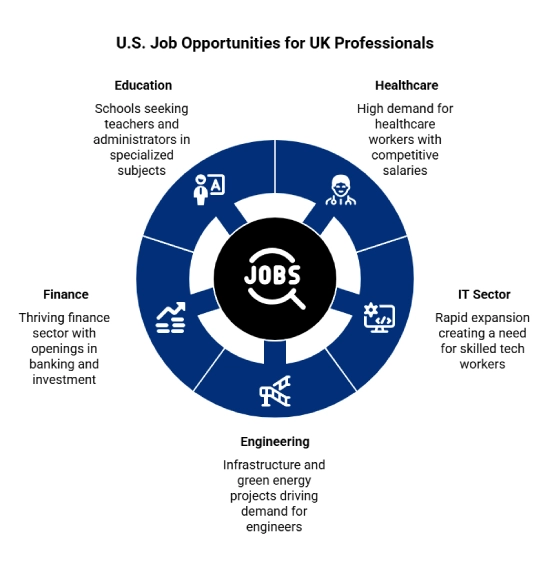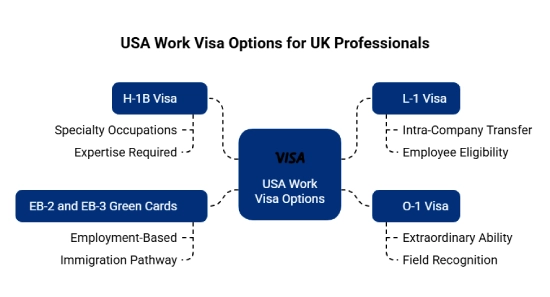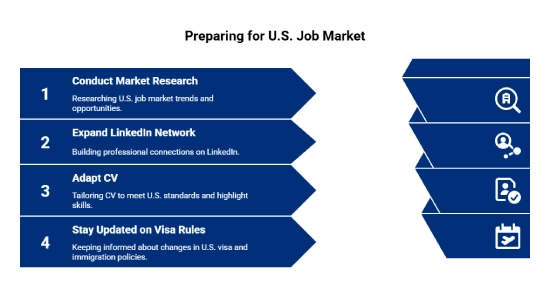The U.S. job market presents many options for skilled workers from the UK. Due to a strong economy, fields like healthcare, IT, engineering, and finance have a growing need for qualified people. For those thinking about working in the U.S., it's important to know which jobs are most needed and to get the correct work visa.

*Want assistance to apply for USA work visa? Y-Axis is here to assist you with the process.
For professionals from the UK, working in the USA can lead to better careers and personal growth. The US job market is varied, the standard of living is good, and many global industries are present. The USA also provides chances to advance one's career, meet people in one's field, and maybe become a permanent resident. Because of good salaries, a lively culture, and leading firms, many professionals around the world want to work there.
The job market in the USA is predicted to keep growing, especially in healthcare, IT, and renewable energy. There will still be a high need for skilled workers, mostly in tech, engineering, and finance. Also, the aging population and new medical tech are expected to make the healthcare industry grow fast. As businesses keep changing to digital systems, tech workers, like software developers and cybersecurity pros, will be very important.
At present, the U.S. job market has a big need for workers in areas like health, tech, and skilled trades. Some of the jobs that are needed most include registered nurses, and software engineers, along with many jobs that support health services. Also, restaurants and food service places need people, and there are lots of openings for skilled workers such as electricians.
*Looking for guidance to apply for suitable Jobs in USA? Let Y-Axis guide you with the process.
The demand for healthcare workers is rising as the healthcare sector expands. Some crucial job roles include:
| Job Role | Average Salary (USD) |
| Registered Nurse | $75,000 - $90,000 |
| General Practitioner | $120,000 - $200,000 |
| Medical and Health Services Manager | $100,000 - $160,000 |
| Dentist | $150,000 - $200,000 |
| Physical Therapist | $75,000 - $95,000 |
| Pharmacist | $120,000 - $150,000 |
| Surgeon | $250,000 - $500,000+ |
| Psychiatrist | $180,000 - $250,000 |
| Radiologic Technologist | $60,000 - $80,000 |
| Medical Scientist | $80,000 - $120,000 |
Given the continuous development of technology, there is a high need for IT experts. The USA has many jobs in the tech field:
| Job Role | Average Salary (USD) |
| Software Developer | $85,000 - $130,000 |
| Data Scientist | $100,000 - $160,000 |
| Cybersecurity Analyst | $95,000 - $140,000 |
| IT Project Manager | $90,000 - $130,000 |
| Cloud Engineer | $100,000 - $150,000 |
| AI/ML Engineer | $110,000 - $160,000 |
| Network Engineer | $75,000 - $110,000 |
| Systems Administrator | $70,000 - $105,000 |
| IT Support Specialist | $50,000 - $75,000 |
| Web Developer | $60,000 - $100,000 |
The field of engineering, especially civil, mechanical, and renewable energy, is seeing consistent growth. Typical positions include:
| Job Role | Average Salary (USD) |
| Civil Engineer | $70,000 - $105,000 |
| Mechanical Engineer | $75,000 - $110,000 |
| Electrical Engineer | $80,000 - $120,000 |
| Renewable Energy Engineer | $85,000 - $120,000 |
| Construction Manager | $90,000 - $135,000 |
| Environmental Engineer | $75,000 - $100,000 |
| Industrial Engineer | $85,000 - $120,000 |
| Chemical Engineer | $95,000 - $130,000 |
| Aerospace Engineer | $100,000 - $150,000 |
| Software Engineer | $95,000 - $135,000 |
In the U.S., the finance and accounting field continues to present many profitable career paths.
| Job Role | Average Salary (USD) |
| Financial Analyst | $70,000 - $100,000 |
| Accountant | $55,000 - $80,000 |
| Investment Banker | $100,000 - $200,000 |
| Tax Advisor | $80,000 - $120,000 |
| Auditor | $65,000 - $95,000 |
| Actuary | $90,000 - $140,000 |
| Financial Controller | $95,000 - $140,000 |
| Portfolio Manager | $120,000 - $200,000 |
| Financial Planner | $75,000 - $110,000 |
| Risk Manager | $85,000 - $130,000 |
The field of education is seeing increased demand for teachers, producing plentiful job openings for experts in the UK.
| Job Role | Average Salary (USD) |
| Secondary School Teacher | $45,000 - $70,000 |
| College Professor | $65,000 - $120,000 |
| Education Administrator | $80,000 - $130,000 |
| Special Education Teacher | $50,000 - $70,000 |
| Librarian | $50,000 - $75,000 |
| Early Childhood Educator | $40,000 - $55,000 |
| Curriculum Developer | $60,000 - $85,000 |
| Instructional Coordinator | $55,000 - $80,000 |
| Principal | $90,000 - $130,000 |
| Education Consultant | $60,000 - $100,000 |
To be employed in the U.S., professionals from the U.K. usually need to get a work visa. Common types of visas include:

The H-1B visa lets firms in the U.S. hire foreign workers for jobs that need specialized knowledge. To qualify for these jobs, applicants usually must have at least a bachelor's degree in the related field, or something equivalent. The visa applies to a particular employer, job, and location.
The L-1 visa, a non-immigrant option in the U.S., enables global companies to move staff from overseas offices to the United States on a temporary basis. This visa is intended for workers transferring to a U.S. branch, subsidiary, or related company. The L-1 visa has two classes: the L-1A, for executives and managers, and the L-1B, for employees with specialized knowledge.
The O-1 visa is for people with skills above the usual in areas like science, arts, education, business, or sports. It also applies to those with a history of great success in film or TV. This visa lets these people work in the U.S. for a limited time.
These US green cards are for those skilled foreign nationals with skills, professionals, and other workers who want to live in the U.S. for good.
The primary differences between EB-2 and EB-3 visas are given below.
| Visa Type | EB-2 (Second Preference) | EB-3 (Third Preference) |
| Who can apply? | Advanced degree holders or people with special talents in science, art, or business | Skilled workers (2 years of training/experience), professionals with a bachelor’s degree, other workers needing less than 2 years of training |
| Advanced Degree | Master's degree or a Bachelor's degree + 5 years of experience | Not applicable |
| Special Talent | Must demonstrate exceptional ability in science, art, or business | Not applicable |
| National Interest Waiver (NIW) | Available – can apply without a job offer if the work benefits the U.S. | Not available |
| Labor Certification | Usually required, U.S. employer must obtain certification from Labor Department | Usually required, U.S. employer must obtain certification from Labor Department |
| Skilled Worker/Experience | Not applicable, focuses on advanced degrees and talents | 2 years of job experience or training in a skilled job |
| Professionals | Not applicable, only advanced degrees and exceptional talents are considered | People with a bachelor's degree (or its equivalent from another country) |
| Other Workers | Not applicable | Unskilled labor requiring less than two years of training |
| Waiting Times | Often shorter processing times than EB-3, depending on country of origin | Usually longer waiting times compared to EB-2 |
| Labor Certification Process | Requires labor certification for most applicants | |
The eligibility criteria for USA work visas are given below.
.webp)
The process to apply for USA work visa is given below.
Step 1: Secure a job offer from a U.S. company.
Step 2: Have your employer file a petition with U.S. Citizenship and Immigration Services (USCIS).
Step 3: compile your paperwork. This usually includes your resume, diploma, and any professional licenses you hold.
Step 4: submit your visa application and attend the interview.
Step 5: if your application is approved, you’ll get your visa.
Detailed information about the processing times for USA work visa application is given below.
| Visa Type | Processing Time |
| H-1B Visa (Specialty Occupations) | 3 to 6 months |
| L-1 Visa (Intra-Company Transfer) | 2 to 3 months |
| O-1 Visa (Extraordinary Ability) | 1 to 2 months |
| EB-2 and EB-3 Green Cards | 12 to 24 months (may vary) |
Detailed information about the application costs of USA work visa is given below.
| Visa Type | Estimated Application Fee (USD) |
| H-1B Visa (Specialty Occupations) | $460 – $2,460 |
| L-1 Visa (Intra-Company Transfer) | $460 – $1,200 |
| O-1 Visa (Extraordinary Ability) | $190 – $460 |
| EB-2 and EB-3 Green Card | $700 – $1,200 |
Step 1: Check U.S. Bureau of Labor Statistics (BLS) data to target high-growth sectors and occupations.
Step 2: Secure a job offer from a U.S. employer willing to sponsor your visa.
Step 3: Have your employer file a petition with U.S. Citizenship and Immigration Services (USCIS).
Step 4: Complete the DS-160 form and pay the visa application fee.
Step 5: Gather required documents, including passport, contract, and credentials.
Step 6: Attend the U.S. consular interview and submit your biometrics.
Step 7: Receive your visa and prepare for relocation to the U.S.
The benefits of working in the USA are given below.

Y-Axis is a well-known immigration consultancy in the UK, drawing on more than 25 years of experience. We provide:
Explore what Global Citizens have to say about Y-Axis in shaping their future
USA Visa Processing
Ramesh Pillalamarri applied for US Visa
Read More...
USA Visa
Shruti came to us as she was told by her
Read More...
USA H1 Visa
Mr. Tejaswara Rao towards his need of ac
Read More...
In 2025, sectors like healthcare, tech (AI, cybersecurity, and data science especially), finance, and engineering are seeing strong growth. Healthcare keeps getting bigger as the population ages, and tech grows with the ongoing shift to digital methods. These fields need more skilled workers, which is good news for professionals in the UK.
The qualifications required to work in the USA are given below.
Yes, there are mult6iple job opportunities for Data Scientists in the USA. In the U.S., data scientists are wanted. As industries depend more on data for choices, the demand for experts in machine learning, AI, and analytics keeps increasing. The tech industry has many chances for data scientists, especially in tech centers such as Silicon Valley, New York, and Austin. Good pay and chances to move up make it a good job choice.
To enhance your chances of securing employment in the USA, you may follow these tips.
The processing time for the USA work visas are given below.
| Visa Type | Processing Time |
| H-1B Visa (Specialty Occupations) | 3 to 6 months |
| L-1 Visa (Intra-Company Transfer) | 2 to 3 months |
| O-1 Visa (Extraordinary Ability) | 1 to 2 months |
| EB-2 and EB-3 Green Cards | 12 to 24 months (may vary) |
The benefits of working in the USA are given below.
Yes, there is a high demand for healthcare professionals in the USA. The U.S. has a strong need for healthcare workers. As the population ages and healthcare needs grow, more doctors, nurses, physical therapists, and other medical staff are required. Fields like geriatrics, nursing, and primary care are especially needed. The pandemic has also increased the demand for healthcare workers countrywide, making it a reliable career option with chances in cities and rural areas.
The H-1B visa lets firms in the United States employ skilled workers from other countries in roles that need at least a bachelor's degree. Professionals from the UK working, for example, in IT, engineering, healthcare, and finance, can apply if they have a job offer. The visa lasts for three years and can be extended. Because there's a limit to how many H-1B visas are given out each year, applicants are often chosen through a lottery.
Yes, you can sponsor eligible family members to come and live with you in the USA. In the U.S., work visas such as the H-1B, L-1, and O-1 let people bring their close family members—spouses and kids under 21—using dependent visas like the H-4, L-2, or O-3. Usually, H-4 visa holders can't work, but those with L-2 visas and some H-4 holders who have an Employment Authorization Document (EAD) are allowed to. Children can go to public schools, and spouses might be able to get work permits or study, depending on the type of visa they have.
The job market in the U.S. is varied, presenting many chances for skilled workers in tech, healthcare, finance, and engineering. Salaries tend to be higher than in the UK, and many major international businesses are located here, mostly in tech centers like Silicon Valley and New York. Getting a job can be tough due to competition, and getting a work visa means dealing with complicated immigration rules. As a leading global economy, the U.S. provides great career growth potential.
According to the U.S. Bureau of Labor Statistics (BLS), the fastest-growing occupations from 2023 to 2033 include:
Note: These roles offer competitive pay and opportunities across both urban and rural areas.
The U.S. labor market is projected to grow by approximately 6.7 million jobs between 2023 and 2033, a 4% increase in total employment. Nearly half of these gains will come from healthcare and social assistance sectors due to an aging population and rising healthcare access. Professional, scientific, and technical services—including engineering, IT consulting, and R&D—are expected to add significant positions as businesses invest in innovation. While growth is steady, some sectors like manufacturing may experience slower gains due to automation. The overall employment landscape will remain competitive, but skilled professionals in high-demand industries will find strong job prospects.
In 2025, the fastest-hiring sectors include:
Note: These sectors are offering competitive pay and benefits to attract skilled professionals.
As of mid-2025, U.S. youth unemployment (ages 16–24) stands at around 7–8%, notably higher than the national average of roughly 4.1%. Younger workers often face greater difficulty securing jobs due to limited experience, a shift towards automation in entry-level roles, and employer preference for industry-specific skills. This gap is particularly visible in sectors like retail and hospitality, where demand has stabilized but competition for positions remains high. Comparatively, unemployment rates among older age groups—especially 25–54—remain significantly lower. Addressing this disparity, federal and state programs are expanding apprenticeship, vocational training, and youth employment initiatives to ease the transition into the workforce.
UK professionals can follow the below steps to apply for a work visa in the US:
Step 1: Secure a job offer from a U.S. employer willing to act as your visa sponsor.
Step 2: Determine the correct work visa category, such as H-1B (specialty occupations), L-1 (intra-company transfers), or O-1 (extraordinary ability).
Step 3: Have your employer file a petition with U.S. Citizenship and Immigration Services (USCIS).
Step 4: Once approved, complete the DS-160 online application form and pay the applicable visa fee.
Step 5: Schedule and attend your visa interview at a U.S. consulate or embassy, providing documents such as your valid passport, employment contract, proof of qualifications, and licensing credentials.
Step 6: Upon approval, receive your visa and travel to the U.S. to begin employment.
UK professionals can follow the below steps to apply for a work visa in the US:
Step 1: Secure a job offer from a U.S. employer willing to act as your visa sponsor.
Step 2: Determine the correct work visa category, such as H-1B (specialty occupations), L-1 (intra-company transfers), or O-1 (extraordinary ability).
Step 3: Have your employer file a petition with U.S. Citizenship and Immigration Services (USCIS).
Step 4: Once approved, complete the DS-160 online application form and pay the applicable visa fee.
Step 5: Schedule and attend your visa interview at a U.S. consulate or embassy, providing documents such as your valid passport, employment contract, proof of qualifications, and licensing credentials.
Step 6: Upon approval, receive your visa and travel to the U.S. to begin employment.